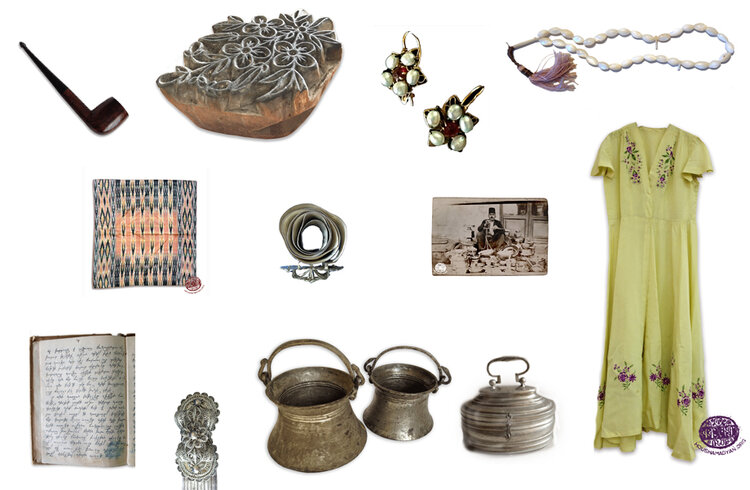Kibarian collection - Paris, France
Jean-Pierre/Shabouh Kibarian from Paris, who is a dentist by profession, gave us these photographs, letters and documents. The name Jean-Pierre Kibarian is quite known within the Armenian studies circles. In 2013, Kibarian published Manuel Minakhorian’s monumental work “A descriptive journey towards Eastern Turkey’s Armenian-populated province” in French, a book that was initially published in Armenian in three parts in 1884-85 in Istanbul.
Jean-Pierre Kibarian’s mother, Lousaper Tatoulian, was born in Ordou/Ordu. She must have been 6-9 years old during the Genocide; she was a witness to the murder of one of her sisters. At the time, Lousaper’s father had already disappeared, while her mother and grandmother were exiled, never to return. Lousaper thus led the life of a vagabond; she was Islamized and had changed her name to Fatima. She found refuge within different Turkish, Kurdish and Georgian families… Eventually, a Greek told the Protestant American missionaries about Lousaper, who brought her to Istanbul (most probably after the Armistice) where she would find refuge with the Djiladjian family (Armenian Protestant). Lousaper later learned that the Armenian Prelate of Paris, Archbishop Vramshaboush Kibarian ("Archougentz"), was looking for a wife for one of his sons – Vagharshag. She presented herself as a candidate, went to Paris and married a much older Vagharshag in 1934. They would have two children: Takouhi (1935) and Shabouh/Jean-Pierre (1946).
Jean-Pierre’s father Vagharshag was born in Shabin-Karahisar/Şebinkarahisar. Vagharshag’s father, Vramshabouh, was the priest of the village and was married to Takouhi - they had three daughters: Aramanoush, Siranoush and Haiganoush, and two sons: Haig-Aram (born in 1886) and Vagharshag (born in 1888). During the reign of Sultan Abdülhamid II, the ottoman authorities exiled Vramshaboush (born in 1855) from Shabin-Karahisar to Istanbul. In 1894, his wife Takouhi would suddenly pass away. Given these circumstances, little Vagharshag was sent to be under the care of his uncle Sarkis, who was a baker in Istanbul. In the meantime, Vagharshag’s father, the priest Vramshaboush, received a higher rank in his priesthood (vartabed) and was sent to Paris, where he became the Armenian community’s pastor. Later he would become the French-Armenians’ prelate (1926). He died in Paris in 1940.
We know that one of Vramshabouh’s brothers, Hovhandjan, and his wife, were killed in Shabin-Karahisar during the Genocide. Their son, Vahan, would participate in the Armenian resistance in Shabin-Karahisar and was killed while fighting. We also know that one of Vramshabouh’s daughters, Siranoush, was also killed during the Genocide; she was exiled with her whole family, and according to the family’s orally-passed micro-history, she would throw herself in the Euphrates River holding her son, Hagop, in her hands…
1) Father (later Archbishop) Vramshabouh Kibarian’s daughters photographed in Kadıköy, Istanbul. From left to right are: Siranoush, Aramanoush and Haiganoush.
2) Kadıköy, Istanbul, 1897. Father Vramshabouh Kibarian is in the middle of the photo. Seated are: Hagop (the priest’s father) on the left, and his mother-in-law (Takouhi’s mother) on the right.
1) Vagharshag Kibarian’s passport issued by the Government of Grand National Assembly of Turkey (Türkiye Büyük Millet Meclisi Hükümet). Vagharshag is to the left of the photo. The photo on the right shows Haiganoush (Vagharshag’s sister) and her two children.
2) Lousaper’s (born in Ordou, Vagharshag’s future wife) turkish passport issued by the Government of Grand National Assembly of Turkey.
Vahan Kibarian’s business card in three languages: Ottoman, Armenian and in Latin characters. There is also Vahan’s photo on the business card. The address says: Shabin-Karahisar. He was Father Vramshabouh Kibarian’s brother Hovhandjan’s son. He participated in the Armenian resistance (1915) in Shabin-Karahisar and was killed while fighting.
1) Aramanoush Kibarian and Tomas Sevhonkian/Karakashian’s wedding photo. Aramanoush was Father Vramshabouh Kibarian’s daughter. Tomas was a bookseller, initially in Shabin-Karahisar, later in Istanbul and much later in Cairo.
2) Sarkis Kibarian’s wedding photo, Istanbul (in the Kadıköy neighborhood), 1900. Sarkis was Father Vramshabouh Kibarian’s brother.
Hovhandjan Kibarian’s family (Hovhandjan is Vramshabouh’s brother), in Shabin-Karahisar/Şebinkarahisar, in 1890 or 1891. Seated from left to right: Boghos Beylerian, his wife Hamaspyour, Norarev Kibarian (Hovhandjan’s wife), and Hrantine Bargeshd (on Norarev’s lap), Hovhandjan Kibarian. Standing from left to right: Vahan, Armenouhi (both are Hovhandjan’s and Norarev’s children).















